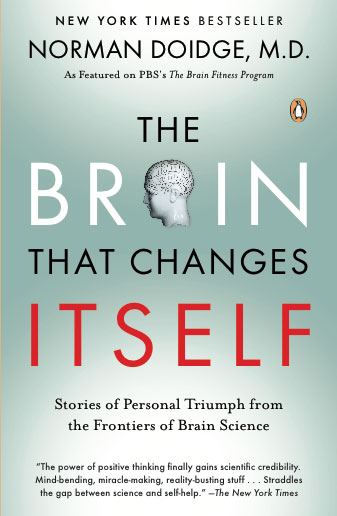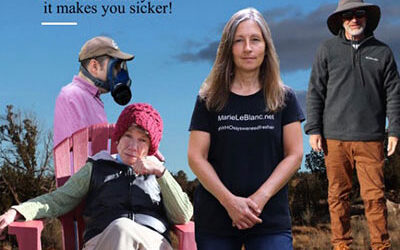 Since learning of Annie Hopper’s recovery from severe chemical and electrical sensitivity and fibromyalgia using brain plasticity exercises, I became fascinated with this relatively new field of research. I devoured Norman Doidge, MD’s book The Brain That Changes Itself, required reading for Annie’s Dynamic Neural Retraining System™ workshop, and promptly wrote to him about my own personal struggle and that of my boyfriend, imploring him to turn his focus on those with environmental sensitivities and asking for any contacts he might have working with this mysterious condition. I also wrote to neurologist V. S. Ramachandran, M.D., PhD., of phantom limb mirror box fame, as well as several others researching and writing about neuroplasticity.
Since learning of Annie Hopper’s recovery from severe chemical and electrical sensitivity and fibromyalgia using brain plasticity exercises, I became fascinated with this relatively new field of research. I devoured Norman Doidge, MD’s book The Brain That Changes Itself, required reading for Annie’s Dynamic Neural Retraining System™ workshop, and promptly wrote to him about my own personal struggle and that of my boyfriend, imploring him to turn his focus on those with environmental sensitivities and asking for any contacts he might have working with this mysterious condition. I also wrote to neurologist V. S. Ramachandran, M.D., PhD., of phantom limb mirror box fame, as well as several others researching and writing about neuroplasticity.
I feel it is of utmost importance to bring our plight to the attention of those working on the cutting-edge of this field; the physicians and scientists who know firsthand that important medical breakthroughs are usually scoffed at by the medical community when first presented, and who would be more likely to acknowledge the physiological basis of environmental intolerance and the potential of neural plasticity to treat it.
From my letter to Dr. Doidge:
…I am writing to you to see if you have given any thought to this condition or come across neuroscientists working in this field, and if you have any theories/ideas about how to rewire the brain for chemical intolerance. This is a horrible condition that can be so severely disabling and so many people are suffering needlessly in complete isolation around the world. Having started on this path of research for a possible cure, it seems so very hopeful, and I wanted to get your input since you have surveyed this promising field in depth.”
Dr. Doidge was one of the few who wrote back. But rather than answering my questions he sent me his own set of questions, eager to learn more. I told him about Annie Hopper and Ashok Gupta, two self-recovered patients who used brain plasticity exercises to get well, and later sent him links to interviews published on Planet Thrive with both these brain retrainers. In a phone call with Hopper I shared my contact with Dr. Doidge and encouraged her to connect with him and other neuroscience researchers to share this new application of brain plasticity as a healing aid for those with disabling environmental sensitivities. Dr. Doidge was very receptive and invited her to have a face-to-face meeting in Canada last month. Very exciting news for those of us with severe environmental sensitivities that may be, at least in part, caused by a toxic brain injury that can be treated with brain plasticity exercises – if only we could get some of the top neuroscientists interested in our condition and monies appropriated to studying potential treatments!
In her latest newsletter, Annie writes of her meeting with Doidge:
Another remarkable moment worth noting here is the personal invitation to meet with Dr. Norman Doidge — author of the best selling book The Brain That Changes Itself — in Toronto last month. He was curious about the Dynamic Neural Retraining System, its neuroplastic implications and interested in stories of people whose lives have been changed through neuroplasticity.
During our 5 hour meeting we discussed Chemical Sensitivities, the immense challenges that it represents for those who live with this disability, the degree of unimaginable suffering involved for those who are severe in nature, the politics behind the chemical industry, and the results of using neuroplasticity exercises to help rewire the brain to assist in recovery from Limbic System Disorders such as Chemical Sensitivities, Chronic Fatigue Syndrome, Chronic Pain, Anxiety and Fibromyalgia.
It was also an opportunity to discuss the environmental impact of chemicals on the human brain and body and the need to change the way we live on this planet. I believe the meeting was a huge success in both promoting awareness of Chemical Sensitivities and forwarding the goal to bring this issue to the neuro science community. Although no promises were made in terms of research – he agreed that the work is credible and that it makes sense. We’re confident this is just the start of bringing this condition to the forefront of leading neuroscientists.”
We at Planet Thrive encourage you to send us any pertinent articles about neuroscientists conducting research that may be related to environmental sensitivities, including studies in addiction, which Claudia Miller, PhD. postulated was related to chemical intolerance with her TILT theory. We would like to stay on top of this and bring this issue to the attention of prominent neuroscientists whenever possible.









Very interested and excited about the potential of this in treating a wide variety of conditions including; depression, anxiety, obesity, OCD, sexual dysfunction. Currently am psychologist working in rural victoria australia. Would be thrilled to hear from people who have advanced the body of knowledge regarding treatment and threatment potential throught therapy.
I have been sufering for years and also suffer from depression and bi-polor. So I am on medication that I don’t really know what helps what if any at all. I am very concerned what the medication will do on the long run. Thank you very much for your information. Valerie